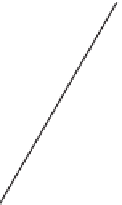Environmental Engineering Reference
In-Depth Information
w
x
3
r
×
v
m
⊗
v
r
q
O
−
r
× −
v
−
r
m
Figure 10.1
A light rod with a mass at either end rotating about the centre of the rod.
fact that
L
⊥
is non-zero implies that the angular momentum vector about
O
is
not
parallel to the angular velocity
. In our previous discussion of the angular
momentum of rigid bodies in Chapter 4 we only needed the component
L
3
in the
direction of
ω
and ignored terms like
L
⊥
. Since torque is equal to the time rate
of change of angular momentum, we can spot straight away that the rotating
L
⊥
component implies that an external torque has to be acting on the masses in order
for them to perform the uniform circular motion about the
x
3
axis. Notice that we
have just discussed the physics in two stages. We first talked about the connection
between
ω
ω
and
L
and then we linked the rate of change of
L
with a torque. This
chapter mirrors that procedure and so first we shall concentrate on how
L
and
ω
are connected for a general rigid body. Then we will turn our attention to relating
the rate of change of the angular momentum to the applied torque, i.e. we will
solve for the motion of the body.
10.1 THE ANGULAR MOMENTUM OF A RIGID BODY
A body is considered rigid if we can think of it as being composed of particles
whose relative positions do not change with time. Even if we are considering a
body with an apparently smooth matter distribution, the 'particles' may be thought
of as being infinitesimal volume elements each containing a tiny bit of matter, the
position of which we can track precisely (see Figure 10.2). If these bits of matter
do not move relative to each other the body is rigid. For such a body we can always
find a frame of reference in which the particles are always stationary. This is a
frame which therefore moves with the body and it is known as a body-fixed frame.
It immediately follows that the position vectors of all the particles are constants in
a body-fixed frame. When the body is rotating in an inertial frame of reference,
the body-fixed frame is clearly non-inertial. To construct equations of motion we












